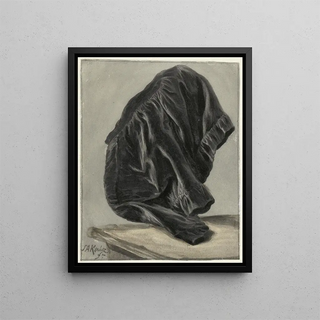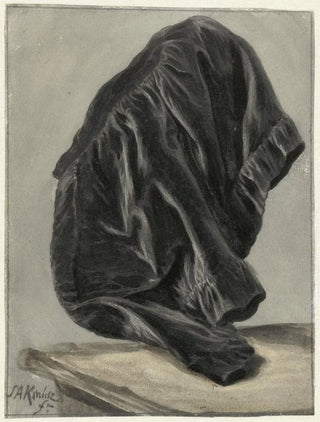Art print | Drapery study - Simon Andreas Krausz


View from behind

Frame (optional)
Art print Study of Drapery - Simon Andreas Krausz – Captivating Introduction
The artwork "Study of Drapery" by Simon Andreas Krausz stands as a fascinating testament to the art of draping, a technique that has endured through the ages to capture the beauty and complexity of fabrics. In this study, Krausz, through a subtle play of light and shadow, manages to breathe an almost palpable life into the folds of the cloth. Every curve, every undulation not only evokes texture but also a deep emotion, inviting the viewer to immerse themselves in a world where matter and spirit converge. This piece, far from being a simple representation, is an exploration of forms and how they interact with the surrounding space.
Style and uniqueness of the artwork
Krausz's style is distinguished by striking realism, the result of meticulous observation and mastered technique. The artist succeeds in transcending the mere depiction of drapery to make it a fully narrative element. The nuances of color and the play of light demonstrate an in-depth understanding of material properties. In "Study of Drapery," each fold becomes an expression of movement, each shadow an invitation to contemplation. The composition, although centered on an apparently static subject, evokes a lively dynamism, as if the fabric were about to come to life. This exceptional rendering showcases Krausz's skill in marrying classical technique with modern sensitivity, making this work a true masterpiece.
The artist and his influence
Simon Andreas Krausz, an emblematic figure of his time, left an indelible mark on the art world. His approach to draping is rooted in a rich artistic tradition, while also bringing his own vision. Influenced by the great masters of the past, he reinterprets ancient techniques with freshness and originality unique to him. Krausz does not merely reproduce forms; he seeks to understand and convey the very essence of the materials he depicts. His work has inspired many contemporary artists, who see in him a model of innovation and respect for tradition. Through his works, he invites reflection on the beauty of everyday life, transforming ordinary objects into

Matte finish

View from behind

Frame (optional)
Art print Study of Drapery - Simon Andreas Krausz – Captivating Introduction
The artwork "Study of Drapery" by Simon Andreas Krausz stands as a fascinating testament to the art of draping, a technique that has endured through the ages to capture the beauty and complexity of fabrics. In this study, Krausz, through a subtle play of light and shadow, manages to breathe an almost palpable life into the folds of the cloth. Every curve, every undulation not only evokes texture but also a deep emotion, inviting the viewer to immerse themselves in a world where matter and spirit converge. This piece, far from being a simple representation, is an exploration of forms and how they interact with the surrounding space.
Style and uniqueness of the artwork
Krausz's style is distinguished by striking realism, the result of meticulous observation and mastered technique. The artist succeeds in transcending the mere depiction of drapery to make it a fully narrative element. The nuances of color and the play of light demonstrate an in-depth understanding of material properties. In "Study of Drapery," each fold becomes an expression of movement, each shadow an invitation to contemplation. The composition, although centered on an apparently static subject, evokes a lively dynamism, as if the fabric were about to come to life. This exceptional rendering showcases Krausz's skill in marrying classical technique with modern sensitivity, making this work a true masterpiece.
The artist and his influence
Simon Andreas Krausz, an emblematic figure of his time, left an indelible mark on the art world. His approach to draping is rooted in a rich artistic tradition, while also bringing his own vision. Influenced by the great masters of the past, he reinterprets ancient techniques with freshness and originality unique to him. Krausz does not merely reproduce forms; he seeks to understand and convey the very essence of the materials he depicts. His work has inspired many contemporary artists, who see in him a model of innovation and respect for tradition. Through his works, he invites reflection on the beauty of everyday life, transforming ordinary objects into






